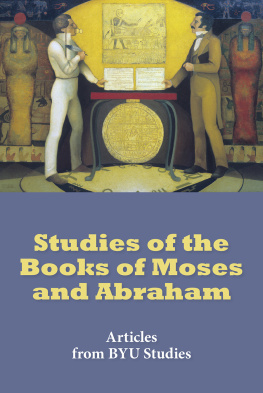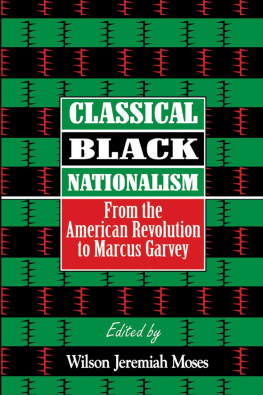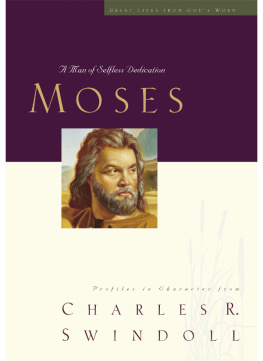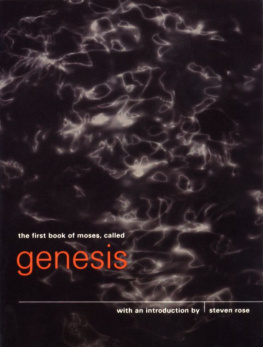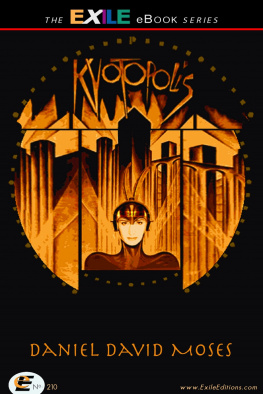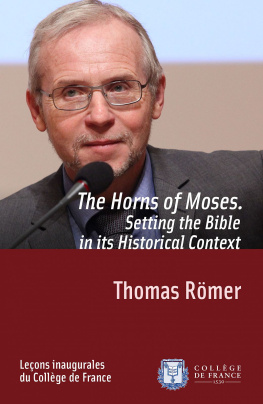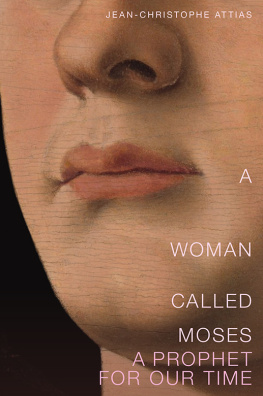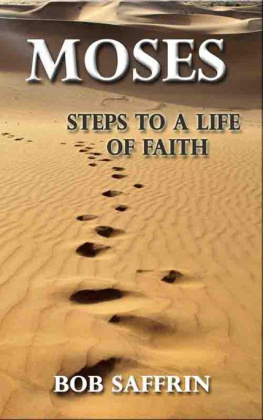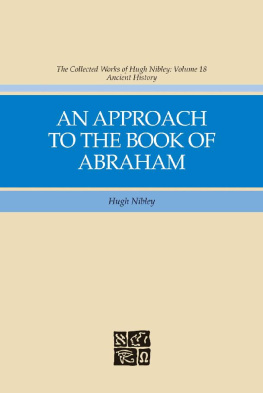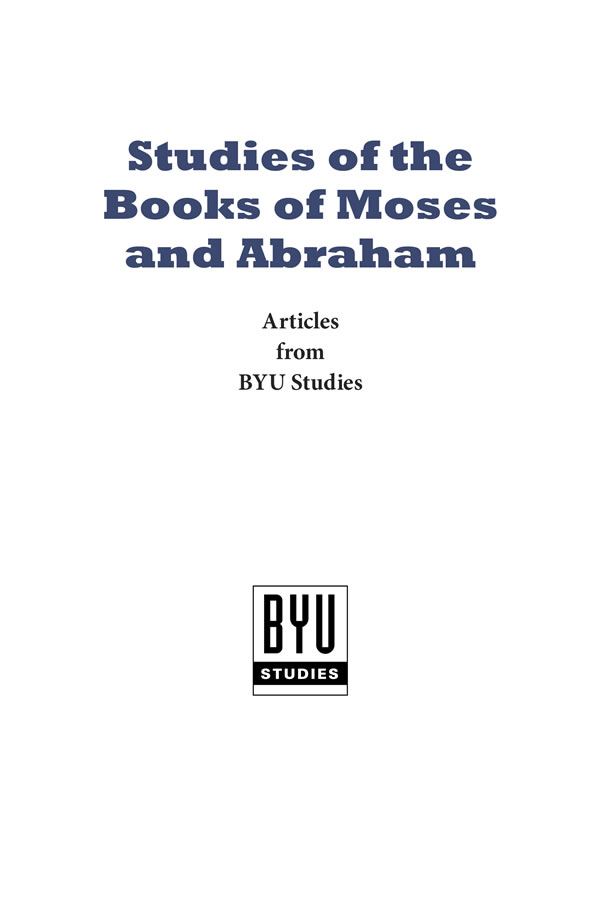2014 Brigham Young University.
Opinions expressed in this publication are the opinions of the authors and their views should not necessarily be attributed to The Church of Jesus Christ of Latter-day Saints, Brigham Young University, or BYU Studies.No part of this book may be reprinted or reproduced or utilized in any form or by any electronic, digital, mechanical or other means, now known or hereafter invented, including photocopying and recording or in an information storage or retrieval system, without permission in writing from the publisher. To contact BYU Studies, write to 1063 JFSB, Brigham Young University, Provo, Utah 84602, or visit http://byustudies.byu.edu.
Front cover: Prophet and Critic by Gary Ernest Smith, courtesy Church History Museum. Intellectual Reserve, Inc.
A Prologue to Genesis:
Moses 1 in Light of Jewish Traditions
E. Douglas Clark
First published in BYU Studies 45, no. 1 (2006): 12942.
Referring to ancient and long-lost scripture that Joseph Smith restored, Wilford Woodruff declared it to be part of the rich treasures that are revealed unto us in the last days.
Beginning with the work of Hugh Nibley, scholars writing on Joseph Smith have focused on the Prophets retrieval of the ancient past, as exemplified by a session at the 2005 Library of Congress conference entitled Joseph Smith and the Recovery of Past Worlds.
Moses 1 was revealed shortly after the organization of the Church to the twenty-four-year-old Joseph Smith, who prefaced the account with these words: Amid all the trials and tribulations we had to wade through, the Lord, who well knew our infantile and delicate situation, vouchsafed for us a supply of strength, and granted us line upon line of knowledgehere a little and there a little, of which the following was a precious morsel.
The famous opening words of Genesis, In the beginning, launch the reader immediately into the creation account without any hint of authorship. Not so in the book of Moses, whose first chapter serves as a kind of prologue
The prevailing academic theory of the origin of the book of Genesis denies Mosaic authorship, claiming instead that Genesis is a synthesis of several different source documents that were redacted or edited into the Pentateuch long after the time of Moses.
Curiously, however, as pointed out in the Encyclopaedia Judaica, Genesis itself contains no information about its authorship, nor can any biblical passage be cited in support of a tradition concerning it. The book of Moses prologue asserting Mosaic authorship has no counterpart in any of the extant ancient Bible translations of Genesis such as the Septuagint (early Greek) or the Samaritan Pentateuch, nor in any of the Aramaic paraphrases (known as Targums). Nor is any such prologue to be found in the Genesis story as retold by the first-century historian Josephus, nor in the retellings by Pseudo-Philo, Jasher, or the Chronicles of Jerahmeel.
But the most ancient Jewish retelling of Genesis, a work called the book of Jubilees which was unknown in Joseph Smiths day, does in fact begin with a prologue that has remarkable parallels to Moses 1. Both of these introductory texts act as prologues to writings of Moses. Other striking parallels are also found in additional ancient texts and traditions, none of which, in all likelihood, were known to Joseph Smith. This short study will explore these parallels, along with the unique value of Moses 1 for Latter-day Saints.
An Ancient Surviving Prologue to a Genesis Account
Throughout the history of ancient Israel, much of the sacred literature of the Hebrews was recorded and compiled into the Pentateuch.
Scholars traditionally date the composition of Jubilees to the second century bc, making it the earliest
The first thing one notices about Jubilees is that, in contrast to Genesis, the creation account is preceded by an entire chapter of prologue that describes the setting for the subsequent divine revelation to Moses. Moses is divinely summoned to a mountain where he experiences Gods glory and is instructed to record what he would be told. He is then apprised of the future apostasy of the children of Israel after they are settled in the promised land and how they would kill the prophets and go into captivity. He learns that eventually, however, the children of Israel would repent and be transplanted back as a righteous plant. Following Moses intercessory prayer, in which he pleads with the Lord to show mercy and salvation to the people, Moses is again instructed to write everything that should be made known to him, and the angel of the presence is told to dictate to Moses the whole account of the creation and the division of years until all creation would be renewed by the powers of heaven.
The similarities to the prologue in the book of Moses are striking, beginning with the fact that each of the two prologues constitutes an entire prefatory chapter providing the setting for the subsequent divine revelation to Moses about the creation and early history of the world. In addition, in both versions Moses is atop a mountain when the Lords glory is made manifest to him (Moses 1:12; Jubilees 1:13). Both tell that Moses learned not only about what had gone before but also about things yet to come (Moses 1:41; Jubilees 1:4). In both versions Moses is instructed to write what he sees in a book for the benefit of those who would live in a future time (Moses 1:4042; Jubilees 1:56). And both mention a future age of divine revelation to those who would believe (Moses 1:4142; Jubilees 1:2225).
There are also important differences between the two accounts, as when, for example, Moses 1 recounts that Moses was taught about the Only Begottena feature understandably absent from Jubilees, which came down to us through Jewish hands. Nor does Jubilees tell of Moses encounter with Satan or of the Lords grand purpose in his vast creations, all as chronicled in Moses 1.
Other Echoes of the Restored Prologue
Other parallels to Moses 1 absent in Jubilees are found in yet other ancient Jewish traditions, including those preserved in pseudepigraphical texts, rabbinic commentary, medieval Kabbalistic texts, and other traditions handed down. These additional parallels are remarkably specific and cumulatively impressive.
Moses Theophany as an Ascension. In Moses 1, Moses theophany takes place not on a mountain that he has climbed but rather on an exceedingly high mountain to which he has been caught up (Moses 1:1). One rabbinic source, commenting on what Moses beheld at the burning bush, notes that what the righteous see ennobles them, because it elevates them to the loftiest heights.
The Transfiguration of Moses. In the Joseph Smith account, The glory of God was upon Moses; therefore Moses could endure his presence (Moses 1:2), and Moses later mused: Mine own eyes have beheld God; but not my natural, but my spiritual eyes, for my natural eyes could not have beheld; for I should have withered and died in his presence; but his glory was upon me; and I beheld his face, for I was transfigured before him (Moses 1:11). Likewise, rabbinic texts disclose that as Moses was taken up from the burning bush to a higher place, he knew that as mere flesh and blood he could not endure the divine presence and was gloriously transfigured so that his flesh resembled fire.
The Timing of Moses Theophany. In Moses 1, Moses theophany precedes the Exodusthe very task Moses was assigned to perform: Blessed art thou, Moses, for I, the Almighty, have chosen thee, and thou shalt be made stronger than many waters; for they shall obey thy command as if thou wert God (Moses 1:25). In contrast, Moses theophany in Jubilees occurs on Mount Sinai after Moses had led the children of Israel out of Egypt.

